
Tom Lovell (5 February 1909 – 29 June 1997) was an American illustrator and painter. He was a prolific creator of pulp fiction magazine covers and illustrations, and of visual art of the American West. He produced illustrations for National Geographic magazine, and many others, and painted many historical Western subjects such as interactions between Indians and white settlers and traders. He was inducted into the Society of Illustrators Hall of Fame in 1974 More on Tom Lovell
Terah, with Abram, Sarai, and Lot, then departed for Canaan, but settled in a place named Haran, where Terah died at the age of 205.
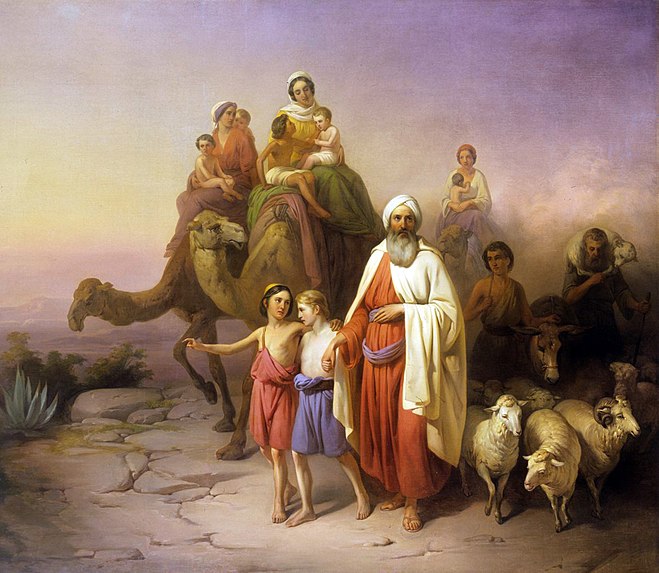
József Molnár (21 March 1821 - 6 March 1899) was a Hungarian painter. Molnár was born in Zsámbék and studied in Venice, Rome and Munich. After his studies, he settled down in Stuttgart, where he earned money by painting portraits. He returned to Hungary in 1853 and started painting landscapes and historic paintings in Pest. More on József Molnár
God had told Abram to leave his country and kindred and go to a land that he would show him, and promised to make of him a great nation, bless him, make his name great, Abram was 75 years old when he left Haran with his wife Sarai, his nephew Lot, and the substance and souls that they had acquired, and traveled to Shechem in Canaan.
Giovanni Benedetto Castiglione (baptized 23 March 1609 – 5 May 1664) was an Italian Baroque artist, painter, printmaker and draftsman, of the Genoese school. He is best known now for his elaborate engravings, and as the inventor of the printmaking technique of monotyping. He was known as Il Grechetto in Italy and in France as Le Benédette. More on Giovanni Benedetto Castiglione
There was a severe famine in the land of Canaan, so that Abram and Lot and their households, traveled south to Egypt. On the way Abram told his wife Sarai to say that she was his sister, so that the Egyptians would not kill him.
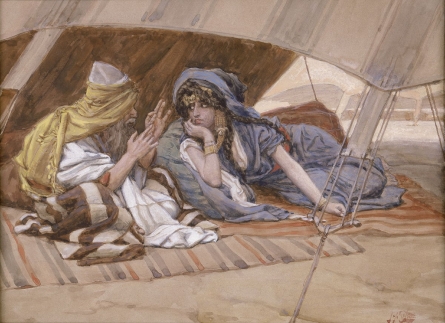
Jacques Joseph Tissot (15 October 1836 – 8 August 1902), Anglicized as James Tissot, was a French painter and illustrator. He was a successful painter of Paris society before moving to London in 1871. He became famous as a genre painter of fashionably dressed women shown in various scenes of everyday life. He also painted scenes and characters from the Bible. More on Jacques Joseph Tissot
(In Egypt was a despotic Pharaoh who had the passionate desire to take possession of married women). When they entered Egypt, the Pharaoh's officials praised Sarai's beauty to Pharaoh, and she was taken into his palace, and Abram was given provisions: "oxen, and he-asses, and menservants, and maidservants, and she-asses, and camels".
Oil on canvas
cm 167 (la) 115.5 (a)
Giovanni Muzzioli (February 10, 1854 – August 5, 1894) was an Italian painter, was born in Modena, after his family had moved from Castelvetro. At the age of 15 years, he began to attend the local Academy of Fine Arts of Modena, working under Antonio Simonazzi and Asioli. At the age of seventeen (1871) he gained the Poletti scholarship entitling him to four years residence in Rome studying at the Accademia di San Luca, working first under professor Podesti, and later after 1874 under professor Coghetti. In Rome, he painted an Abraham and Sarah at the court of the Pharaoh, a painting which he sent back to Modena.
Soon thereafter, he moved to Florence, where he remained the rest of his life. After his return to Modena, Muzzioli visited the Paris Exhibition, and there came under the influence of Sir Lawrence Alma-Tadema, and began painting subjects from classical history of Greece and Rome. His first important pictures were In the Temple of Bacchus and Funeral Rites in Egypt (1881, Milan Exhibition), where the former won a prize of 1000 lire. He captures the epoch, the people, the environment, with a truth, with enviable evidence, (there is here) no phantasmagoria, none of the sophisticated pomp of a scenographer.
At the Esposizione of Venice of 1887 he exhibited September Sun, while in 1888 to Bologna he sent the Funeral of Britannicus. This latter painting was bought by signor Lionello Cavalieri of Ferrara, and is considered his masterpiece, and was much lauded at the Bologna Exhibition. Another work by Muzzioli was Le feste dì Flora.
From 1878 to his death (1894) Muzzioli lived in Florence, where he painted the altarpiece for the church of Castelvetro. Muzzioli was named professor of the Academies of Modena, Florence, and other cities. More on Giovanni Muzzioli
Jacques Joseph Tissot (15 October 1836 – 8 August 1902), See above
However, God afflicted Pharaoh and his household with great plagues, for which he tried to find the reason. Upon discovering that Sarai was a married woman, Pharaoh demanded that they and their household leave immediately, along with all their goods. (But the protection of the Almighty saved her from Pharaoh's evil plot. When Pharaoh summoned Sarah to act on his demented passions, Sarah turned to God in prayer. The moment Pharaoh reached for Sarah, his upper body stiffened. He cried to Sarah in distress, promising to release her if she would pray for his cure! She prayed for his release. But only after a failed third attempt did he finally desist. Realizing their special nature, he let her go and returned her to her supposed brother).

Hollar went to Frankfurt in 1627 where he studied under the engraver and publisher Matthäus Merian, later moving to Strasbourg, and then to Cologne in 1633. There he attracted the attention of the collector Thomas, earl of Arundel, with whom he was associated for most of his life. Hollar settled in England in 1637, but moved to Antwerp in about 1644, and returned to London in 1652.
He was a master etcher, and his work is still much appreciated by connoisseurs. He illustrated a number of books and produced the celebrated Views of London after the Great Fire of 1666. Some 3,000 plates are credited to him. He died in extreme poverty. More on Wenceslaus Hollar
(Sarah returned while Abraham was praying, accompanied by gifts from the Pharaoh, as he had realized their special nature, along with his own daughter Hagar as well, as a handmaiden. She had delivered a powerful message to the Pharaoh and the pagan Egyptians).
When they came back to the Bethel and Hai area (Palestine), Abram's and Lot's sizable livestock herds occupied the same pastures. This became a problem for the herdsmen who were assigned to each family's cattle. The conflicts between herdsmen had become so troublesome that Abram graciously suggested that Lot choose a separate area, either on the left hand (north) or on the right hand (south), that there be no conflict amongst brethren. But Lot chose to go east to the plain of Jordan where the land was well watered everywhere as far as Zoar, and he dwelled in the cities of the plain toward Sodom. Abram went south to Hebron and settled in the plain of Mamre, where he built another altar to worship God.

Andrea del Castagno, pseudonym of Andrea di Bartolo di Simone (born c. 1419, Castagno d’Andrea, near Florence [Italy]—died August 19, 1457, Florence), one of the most influential 15th-century Italian Renaissance painters, best known for the emotional power and naturalistic treatment of figures in his work.
Little is known of Castagno’s early life, and it is also difficult to ascertain the stages of his artistic development owing to the loss of many of his paintings and to the scarcity of documents regarding his extant works. As a youth, he was precocious. He executed a mural of Cosimo de’ Medici’s adversaries (rebels hanging by their heels) at the Palazzo del Podestà in Florence, earning himself the byname Andreino degli Impiccati (“Little Andrea of the Hanged Men”). It is known that he went to Venice in 1442, and frescoes in the chapel of San Tarasio in San Zaccaria are signed and dated by both him and Francesco da Faenza.
In 1451 Castagno continued the frescoes at Sant’Egidio begun earlier by Domenico Veneziano. The light tones that Castagno adopted for his outstanding St. Julian (1454–55) show Domenico’s influence.
In a work for a loggia of the Villa Carducci Pandolfini at Legnaia, Castagno broke with earlier styles and painted a larger-than-life-size series of Famous Men and Women, within a painted framework. In this series Castagno displayed more than mere craftsmanship; he portrayed movement of body and facial expression, creating dramatic tension. Castagno set the figures in painted architectural niches, thus giving the impression that they are actual sculptural forms. His last dated work (in Florence Cathedral) is an equestrian portrait of Niccolò da Tolentino. Castagno’s emotionally expressive realism was strongly influenced by Donatello, Domenico, and perhaps Piero della Francesca, and Castagno’s work in turn influenced succeeding generations of Florentine painters, including Antonio del. More on Bartolo di Fredi
During the rebellion of the Jordan River cities against Elam, Abram's nephew, Lot, was taken prisoner along with his entire household by the invading Elamite forces. The Elamite army came to collect the spoils of war, after having just defeated the king of Sodom's armies. Lot and his family, at the time, were settled on the outskirts of the Kingdom of Sodom which made them a visible target.
One person who escaped capture came and told Abram what happened. Once Abram received this news, he immediately assembled 318 trained servants. Abram's force headed north in pursuit of the Elamite army, who were already worn down from the Battle of Siddim. When they caught up with them at Dan, Abram devised a battle plan by splitting his group into more than one unit, and launched a night raid. Not only were they able to free the captives, Abram's unit chased and slaughtered the Elamite King Chedorlaomer at Hobah, just north of Damascus. They freed Lot, as well as his household and possessions, and recovered all of the goods from Sodom that had been taken.
He spent a period (c. 1528) in the Haarlem studio of Jan van Scorel, then lately returned from Italy. Van Heemskerck’s earliest works—“Ecce Homo” (Musée des Beaux-Arts, Ghent) and “St. Luke Painting the Portrait of the Virgin” (Frans Halsmuseum, Haarlem), both dated 1532—while adhering closely to the Romanist style of Scorel, seek to outdo it by dramatic lighting and illusionistic effects of plasticity.
From 1532 to 1535 he was in Rome, recording in innumerable sketches, some of which are preserved in Berlin, the architecture and sculpture of classical antiquity and the painting of the High Renaissance. Of the latter he directed his attention particularly to the frescoes of Michelangelo in the Sistine Chapel and those of Raphael in the Villa Farnesina.
Throughout the rest of his long career, which was spent almost exclusively in Haarlem, he drew liberally on this garnered store of Roman motifs. Among the more notable of the religious paintings of his maturity are a great “Crucifixion” altarpiece (1538–43; Linköping cathedral, Sweden) and a “Crucifixion” (1543, Ghent). He also painted portraits, among them a self-portrait with the Colosseum (1553; Fitzwilliam Museum, Cambridge, Eng.) and the well-known “Portrait of a Woman at the Spinning Wheel” (Rijksmuseum, Amsterdam). From 1548 onward he produced many designs for engravings. More on Maerten van Heemskerck
Thomas Christian Wink (1738-1797). One of the last great artists of the Rococo era, Winck is best known as a painter and engraver of allegorical and religious subjects. Following his apprenticeships with Anton Scheidler (active 1745-c.1775) and Jacob Feichtmayr (active 1735-1767), Winck became one of the most sought-after fresco and altarpiece artists in Bavaria, patronised by both the church and the nobility. In 1769, he was appointed court painter to the Elector of Bavaria, signing his works, 'Aulae Bojcae Pictor' (Bavarian Court Painter). More on Thomas Christian Wink
Fresco
The Loggia (fresco cycle), Vatican, Rome.
The Loggia of Raphael is a room on the second floor of the Apostolic Palace , in Vatican City , adjacent to the rooms and part of the complex of the Lodges . It is famous for a series of frescoes of the school of Raphael reproducing decorations with biblical stories, dated between the end of 1517 or in 1518 and 1519 .
A second loggia already painted by Raphael is the so-called First Loggia , on the main floor (completely repainted by Alessandro Mantovani in the second half of the nineteenth century); a third is the Loggia of Cardinal Bibbiena , on the third floor. The three lodges, overlooking courtyard of San Damaso, form the complex of the Lodges of Raphael or Vatican Loggia .More on Loggia di Raffaello

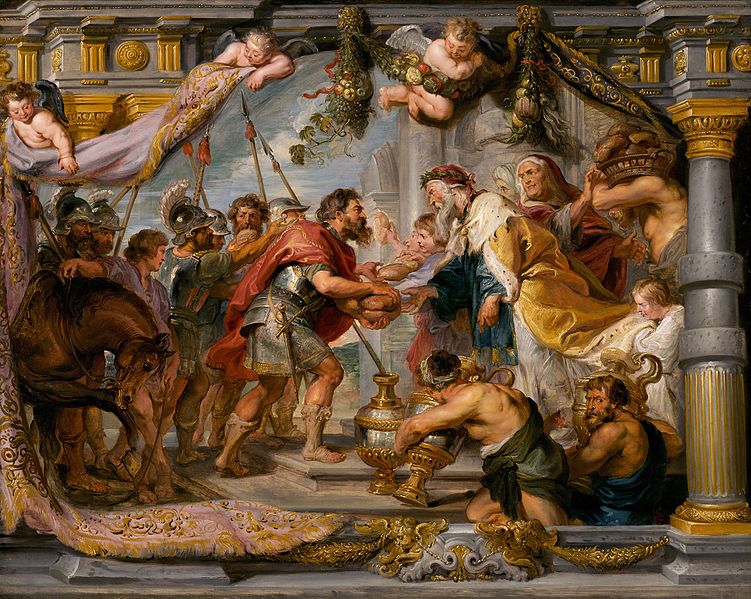
Peter Paul Rubens (1577–1640), See Below
Melchizedek Priest of the God Most High. Perhaps the most mysterious, enigmatic and intriguing figure in all of the Old Testament is Melchizedek the Canaanite priest who makes a brief appearance in the Old Testament in Genesis. He is also mentioned in the Book of Psalms and is referred to eight times in the New Testament Letter to the Hebrews. Speculation, conjecture, and sometimes just pure wild guessing is set forth to explain exactly who this cryptic figure was. More on Melchizedek Priest of the God Most High.
This painting is a modello, or oil sketch, for a tapestries. It depicts the meeting of Abraham and Melchizedek (Genesis 14:1–20). Returning victorious from battle, Abraham is greeted by Melchizedek, high priest and king of Salem, who presents him with loaves of bread as attendants bring vessels of wine. Catholic theologians considered the scene to prefigure the Eucharist. More on this painting
Upon Abram's return, Sodom's king came out to meet with him in the Valley of Shaveh, the "king's dale". Also, Melchizedek king of Salem (Jerusalem), a priest of God Most High, brought out bread and wine and blessed Abram and God. Abram then gave Melchizedek a tenth of everything. The king of Sodom then offered to let Abram keep all the possessions if he would merely return his people. Although he released the captives, Abram refused any reward from the king of Sodom, other than the share to which his allies were entitled.
Abram and Sarai tried to make sense of how he would become a progenitor of nations since after 10 years of living in Canaan, no child had been born. Sarai then offered her Egyptian handmaiden, Hagar, for Abram to consort with so that he may have a child by her, as his wife. (As the gifting of a handmaid by a barren woman to her husband in order to produce offspring seems to have been a common practice of that day, Sarah suggested to Abraham that he take Hagar as his concubine. Some Christian scholars say of this event that he actually took her as his wife. Whichever case it may be, in Jewish and Babylonian tradition, any offspring born to a concubine would be claimed by the concubine’s former mistress and be treated exactly the same as a child born to her, including matters of inheritance).
Tom Lovell (1909 – 1997), See above
At the age of ten he started to take lessons, two years later moving in with Eglon van der Neer, specializing in clothes and draperie. At the age of seventeen he founded his own studio in Rotterdam where he later became the head of guild of Saint Luc. In 1696, he was paid a visit by Johann Wilhelm, Elector Palatine and his wife, Anna Maria Luisa de' Medici. The couple ordered two paintings to be sent to Cosimo III of Tuscany, Anna Maria Luisa's father, in Florence. During the next years Van der Werff traveled regularly between Düsseldorf and his home town. In 1703, he became the official court painter and a knight, when his former teacher and predecessor Van der Neer died. Van der Werff, with a perfect technique, was paid extremely well by the Elector for his biblical or classical (erotic) paintings. In 1705, he painted a portrait of Gian Gastone de' Medici, Grand Duke of Tuscany. In 1716, he lost his job when the Elector died because the treasury was empty.
Van der Werff became one of the most lauded Dutch painters of his day, gaining a European reputation and an enormous fortune. Arnold Houbraken, writing in 1718, considered him the greatest of the Dutch painters and this was the prevailing critical opinion throughout the 18th century: however, his reputation suffered in the 19th century, when he was alleged to have betrayed the Dutch naturalistic tradition. In the Victorian Age people could not appreciate his art, so most of his work went into the cellars of the Alte Pinakothek.
Van der Werff also practised as an architect in Rotterdam, where he designed a few houses. More on Adriaen van der Werff

Sarah Leading Hagar to Abraham, between 1637 and 1639
Oil on canvas
Height: 113 cm (44.4 ″); Width: 168 cm (66.1 ″)
Gemäldegalerie, State Museums of Berlin
Sarah presenting Hagar to Abraham, c. 16th century
Oil on Canvas
28 x 18
Dulwich Picture Gallery, London
After Hagar found she was pregnant, she began to despise her mistress, Sarai. Therefore, Sarai mistreated Hagar, and Hagar fled away.
Hagar Weeping, early 1640s
Oil on canvas
76.2 × 68.6 cm (30 × 27 in.)
Getty Center, Los Angeles, California
This painting was cut from a larger canvas, so we have only part of the original scene. Is this Hagar's first flight from Sarah, or fourteen years later when she is cast into the desert with her son? I would guess it is the former, since Hagar seems like a young girl in this painting, rather than a mature woman. She is turning to look up at the angel behind her, the positioning of her beautiful hand suggesting that she is taken aback by what she sees.
van den Eeckhout was another of Rembrandt's pupils, probably studying with him in the late 1630's. But the style of this painting shows that he had moved away from Rembrandt's influence and was painting images that were clearer and more precise than his teacher's. More on this painting
Gerbrand van den Eeckhout, in full Gerbrand Janszoon van den Eeckhout (born August 19, 1621, Amsterdam, Netherlands—buried September 29, 1674, Amsterdam), Dutch artist and poet who mastered several media, including metalwork, etching, and drawing, but is perhaps best known for his biblical, genre, and group and individual portrait paintings. He was a gifted and favourite pupil of Rembrandt (1635–40), to whom he remained a close friend. Van den Eeckhout’s style, particularly in the biblical paintings, is based so closely on that of his master that many of his pictures have been taken as works by Rembrandt himself. Van den Eeckhout was one of the most successful of this school in adopting the broader and bolder technique of Rembrandt’s mature style. More on Gerbrand van den Eeckhout
This too seems to be an image of Hagar's first vision of the angel - there is no sign of Ishmael. Sarah has forced the younger woman to leave the safety of the tribe and go out into the desert. Alone in the terrifying wilderness, Hagar senses the presence of another being, the Angel of God. She seems too frightened or perhaps too wary to face the Angel directly.
Carel Febritius was a pupil of Rembrandt's, the only one who developed a style completely his own, the only one to step out from under his teacher's shadow. As a young man he worked as a carpenter, and at first only took up painting as a sideline. His talent soon became evident, and he moved to Delft, where he had a strong influence on Vermeer. His paintings, however, are rare, since only about a dozen of them survived a terrible explosion in a gunpowder factory in Delft, which also killed him at the early age of 32. More on Carel Febritius

Lastman received his earliest training from a pupil of Cornelis van Haarlem, a painter of the post-Renaissance Mannerist school. He also shared stylistic affinities with Hendrik Goltzius, another prominent painter in Haarlem. He worked in Rome about 1603–07, where he was profoundly influenced by an important German landscape painter, Adam Elsheimer. By the time he returned to Amsterdam in 1607, he had assimilated Elsheimer’s sensitive feeling for light and atmosphere in landscape. Rembrandt’s Angel and the Prophet Balaam (1626) is based on Lastman’s earlier painting of the same subject (1622). Lastman’s Coriolanus and the Roman Woman and The Baptism of the Chamberlain also influenced the early narrative style of Rembrandt. More on Pieter Lastman
She was told to call her son Ishmael. Hagar then called God who spoke to her "El-roi", ("Thou God seest me:" KJV). From that day, the well was called Beer-lahai-roi, ("The well of him that liveth and seeth me." She then did as she was instructed by returning to her mistress in order to have her child. Abram was eighty-six years of age when Ishmael was born.
Thirteen years later, when Abram was ninety-nine years of age, God declared Abram's new name: "Abraham" – "a father of many nations". Abraham then received the instructions for the covenant, of which circumcision was to be the sign. Then God declared Sarai's new name: "Sarah" and blessed her and told Abraham, "I will give thee a son also of her". But Abraham laughed, and "said in his heart, 'Shall a child be born unto him that is an hundred years old? and shall Sarah, that is ninety years old, bear?'" immediately after Abraham's encounter with God, he had his entire household of men, including himself and Ishmael, circumcised.

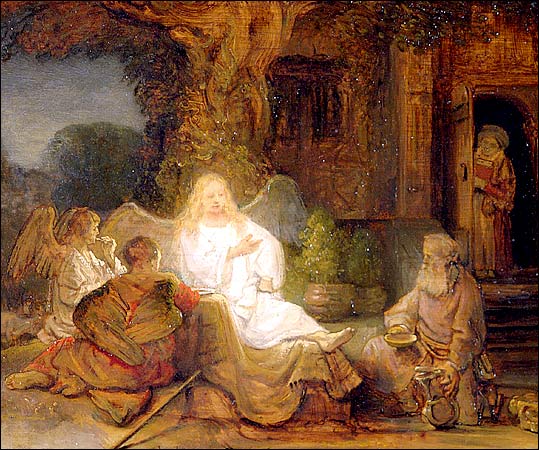
Jan Rembrandt Harmensz. van Rijn, (1606–1669)
Abraham Entertaining the Angels, c. 1656
Rembrandt Harmenszoon van Rijn (15 July 1606 – 4 October 1669) was a Dutch painter and etcher. He is generally considered one of the greatest painters and printmakers in European art and the most important in Dutch history. His contributions to art came in a period of great wealth and cultural achievement that historians call the Dutch Golden Age when Dutch Golden Age painting, although in many ways antithetical to the Baroque style that dominated Europe, was extremely prolific and innovative, and gave rise to important new genres in painting.
Having achieved youthful success as a portrait painter, Rembrandt's later years were marked by personal tragedy and financial hardships. Yet his etchings and paintings were popular throughout his lifetime, his reputation as an artist remained high, and for twenty years he taught many important Dutch painters. Rembrandt's greatest creative triumphs are exemplified especially in his portraits of his contemporaries, self-portraits and illustrations of scenes from the Bible. His self-portraits form a unique and intimate biography, in which the artist surveyed himself without vanity and with the utmost sincerity.
In his paintings and prints he exhibited knowledge of classical iconography, which he molded to fit the requirements of his own experience; thus, the depiction of a biblical scene was informed by Rembrandt's knowledge of the specific text, his assimilation of classical composition, and his observations of Amsterdam's Jewish population. Because of his empathy for the human condition, he has been called "one of the great prophets of civilization. More on Rembrandt Harmenszoon van Rijn
Not long afterward, during the heat of the day, Abraham had been sitting at the entrance of his tent by the terebinths of Mamre. He looked up and saw three men in the presence of God. Then he ran and bowed to the ground to welcome them.
Abraham then offered to wash their feet and fetch them a morsel of bread, of which they assented. Abraham rushed to Sarah's tent to order cakes made from choice flour, then he ordered a servant-boy to prepare a choice calf. When all was prepared, he set curds, milk and the calf before them, waiting on them, under a tree, as they ate.

Aert de Gelder, Aert also spelled Arent (born Oct. 26, 1645, Dordrecht, United Provinces [now the Netherlands]—died Aug. 28, 1727, Dordrecht), the only Dutch artist of the late 17th and early 18th century to paint in the tradition of Rembrandt’s late style.
De Gelder spent his life in Dordrecht, except for a period of time about 1661 when he was Rembrandt’s pupil in Amsterdam. His biblical paintings—e.g., Scenes from the Passion (c. 1715)—feature warm colour and atmospheric light. In his portraits—e.g., The Family of Herman Boerhave (c. 1722)—his bold, broad manner of brushwork and surface texture contrasts markedly with the refined techniques and smoothly finished canvases of his contemporaries. More on Aert de Gelder
One of the visitors told Abraham that upon his return next year, Sarah would have a son. While at the tent entrance, Sarah overheard what was said and she laughed to herself about the prospect of having a child at their ages.
In 1869, he sailed from Swansea to Genoa, and spent the next 6 months travelling and sketching around Italy. On returning to Edinburgh, Hole entered the School of Design, then won admission to the life school of the Royal Scottish Academy, first exhibiting there in 1873; in 1878. Around this time he took up etching and was accepted into the Royal Society of Painters and Etchers (RE) in 1885; he was already a member of the Royal Scottish Watercolour Society (RSW) from 1884. He eventually became a full member of the Academy (RSA).
Around 1900, he travelled to Palestine in order to study the background for biblical painting. There he began working on the 80 watercolours that would eventually appear as illustrations in his book "The Life of Jesus of Nazareth." In April to May 1906 these pictures were shown at an exhibition at the Fine Art Society in London. He also painted scenes from the Old Testament.
Hole died in Edinburgh in 1917. He is buried in the Grange Cemetery in the ground of James Lindsay in the centre of the north wall. His name is listed at the base of the monument along with other members of the Hole family. More on William Brassey Hole

Jan Provoost, or Jean Provost, or Jan Provost (1462/65 – January 1529) was a Belgian painter born in Wallonië (Mons). He was one of the most famous Netherlandish painters of his generation.
Provost was born in Mons. He was a prolific master who left his early workshop in Valenciennes to run two workshops, one in Bruges, where he was made a burgher in 1494, the other simultaneously in Antwerp, which was the economic center of the Low Countries. Provost was also a cartographer, engineer, and architect. He met Albrecht Dürer in Antwerp in 1520, and a Dürer portrait drawing at the National Gallery, London, is conjectured to be of Provost. He married the widow of the miniaturist and painter Simon Marmion, after whose death he inherited the considerable Marmion estate. He died in Bruges.
The styles of Gerard David and Hans Memling can be detected in Provoost's religious paintings. The Last Judgement painted for the Bruges town hall in 1525 is the only painting for which documentary evidence identifies Provost. Surprising discoveries can still be made: in 1971 an unknown and anonymous panoramic Crucifixion from the village church at Koolkerke was identified as Provost's. It is on permanent loan to the Groeninge Museum, Bruges, which has several works of Provost: a retrospective exhibition took place in 2008–9. More on Jan Provoost
The visitor inquired of Abraham why Sarah laughed at bearing a child at her age, as nothing is too hard for God. Frightened, Sarah denied laughing.
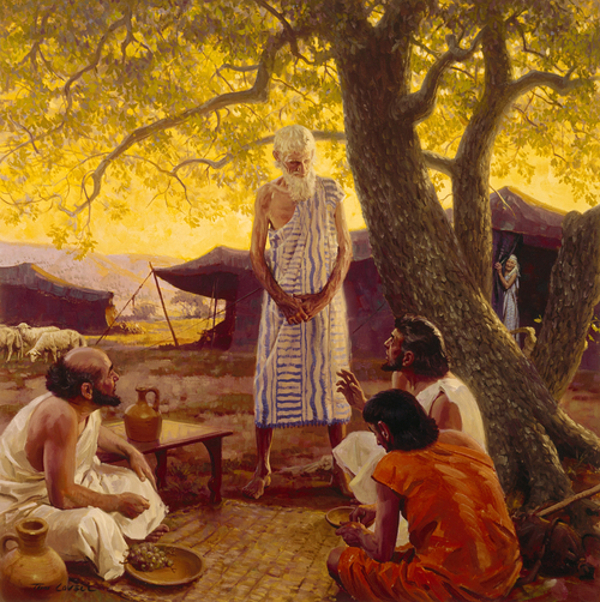

Marc Chagall, ( 24 June 1887 – 28 March 1985)
Abraham and three Angels, c. 1966
oil on canvas
190 x 292 cm
Marc Chagall, (born July 7, 1887, Vitebsk, Belorussia, Russian Empire [now in Belarus]—died March 28, 1985, Saint-Paul, Alpes-Maritimes, France), Belorussian-born French painter, printmaker, and designer. He composed his images based on emotional and poetic associations, rather than on rules of pictorial logic. Predating Surrealism, his early works, such as I and the Village (1911), were among the first expressions of psychic reality in modern art. His works in various media include sets for plays and ballets, etchings illustrating the Bible, and stained-glass windows. More on Marc Chagall
After eating, Abraham and the three visitors got up. They walked over to the peak that overlooked the 'cities of the plain' to discuss the fate of Sodom and Gomorrah for their detestable sins that were so great, it moved God to action. Because Abraham's nephew was living in Sodom, God revealed plans to confirm and judge these cities. At this point, the two other visitors left for Sodom. Then Abraham turned to God and pleaded decrementally with Him that "if there were at least ten righteous men found in the city, would not God spare the city?" For the sake of ten righteous people, God declared that he would not destroy the city.

Sir Peter Paul Rubens (28 June 1577 – 30 May 1640) was a Flemish Baroque painter. A proponent of an extravagant Baroque style that emphasized movement, colour, and sensuality, Rubens is well known for his Counter-Reformation altarpieces, portraits, landscapes, and history paintings of mythological and allegorical subjects.
In addition to running a large studio in Antwerp that produced paintings popular with nobility and art collectors throughout Europe, Rubens was a classically educated humanist scholar and diplomat who was knighted by both Philip IV of Spain and Charles I of England. More on Sir Peter Paul Rubens
When the two visitors got to Sodom to conduct their report, they planned on staying in the city square. However, Abraham's nephew, Lot, met with them and strongly insisted that these two "men" stay at his house for the night. A rally of men stood outside of Lot's home and demanded that they bring out his guests so that they may "know" them.

However, Lot objected and offered his virgin daughters who had not "known" man to the rally of men instead. They rejected that notion and sought to break down Lot's door to get to his male guests, thus confirming that their "cry" had waxed great before God, and they would be destroyed.
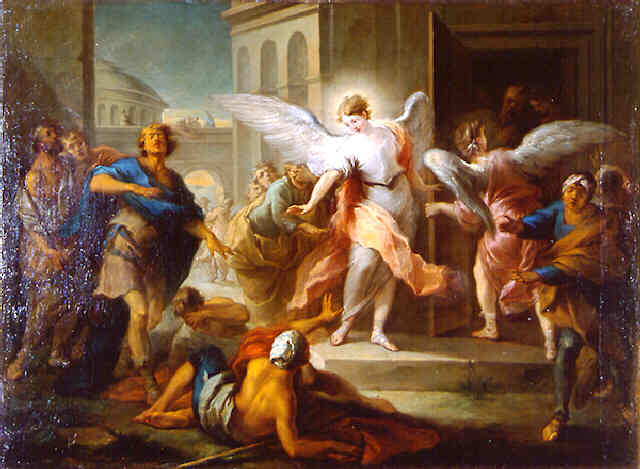
Carle or Charles-André van Loo (15 February 1705 – 15 July 1765) was a French subject painter, son of the painter Louis-Abraham van Loo, a younger brother of Jean-Baptiste van Loo and grandson of Jacob van Loo. He was the most famous member of a successful dynasty of painters of Dutch origin. His oeuvre includes every category: religion, history painting, mythology, portraiture, allegory, and genre scenes.
He was born in Nice, then part of the Duchy of Savoy. Van Loo followed his brother Jean-Baptiste to Turin, and then to Rome in 1712, where he studied under Benedetto Luti and the sculptor Pierre Legros. After leaving Italy in 1723, he worked in Paris, studied at the Académie Royale, where he gained first prize for drawing in 1723, and received the first prize for historical painting in 1727—as did his future rival François Boucher. After again visiting Turin in 1727, he was employed by king Victor Amadeus II of Sardinia, for whom he painted a series of subjects illustrative of Tasso. In 1734 he settled in Paris, and in 1735 became a member of the Académie Royale de Peinture et de Sculpture and rose rapidly in the hierarchy of the academy. Madame de Pompadour and the French court were taking the artist under their patronage. He was decorated with the Order of Saint Michael and named First Painter to king Louis XV of France in 1762. He was a most successful court painter but his portraits as well as history paintings also enjoyed an enormous success throughout all Europe. He died in Paris on 15 July 1765. More on Carle or Charles-André van Loo
Jacques Joseph Tissot (15 October 1836 – 8 August 1902), See above
James Jacques Joseph Tissot (French, 1836-1902), See above
Abraham settled between Kadesh and Shur in the land of the Philistines. While he was living in Gerar, Abraham openly claimed that Sarah was his sister. Upon discovering this news, King Abimelech had her brought to him.

Johann Heinrich Wilhelm Tischbein, (born Feb. 15, 1751, Haina, Hesse [Germany]—died June 26, 1829, Eutin, Oldenburg), German portraitist and friend of the writer J.W. von Goethe.
Tischbein began his career painting portraits at the Prussian court in Berlin. In 1779 he went to Italy and in 1789 was appointed director of the art academy in Naples. Forced to leave in 1799 because of war, the painter retired to northern Germany. Tischbein’s most famous painting, “Goethe in the Campagna,” was painted in 1787 at the time the two men traveled from Rome to Naples. Though Goethe induced the artist to turn his interest toward the Neoclassical movement, Tischbein was later influenced by the ideas of German Romanticism.
Tischbein belonged to a family that produced more than 20 artists in three generations. Others of importance include Johann Heinrich Tischbein the Elder (1722–89), who was a court painter in Kassel, in Hesse, and the portraitists Johann Valentin Tischbein (1715–68) and Anton Wilhelm Tischbein (1730–1804) More on Johann Heinrich Wilhelm Tischbein
God then came to Abimelech in a dream and declared that taking her would result in death because she was a man's wife. Abimelech had not laid hands on her, so he inquired if he would also slay a righteous nation, especially since Abraham had claimed that he and Sarah were siblings. In response, God told Abimelech that he did indeed have a blameless heart and that is why he continued to exist. However, should he not return the wife of Abraham back to him, God would surely destroy Abimelech and his entire household. Abimelech was informed that Abraham was a prophet who would pray for him.
Nicolaes Pieterszoon Berchem (1 October 1620 – 18 February 1683) was a highly esteemed and prolific Dutch Golden Age painter of pastoral landscapes, populated with mythological or biblical figures, but also of a number of allegories and genre pieces.
He was a member of the second generation of "Dutch Italianate landscape" painters. These were artists who travelled to Italy, or aspired to, in order to soak up the romanticism of the country, bringing home sketchbooks full of drawings of classical ruins and pastoral imagery. His paintings, of which he produced an immense number, were in great demand, as were his etchings and drawings. His landscapes, painted in the Italian style of idealized rural scenes, with hills, mountains, cliffs and trees in a golden dawn are sought after. Berchem also painted inspired and attractive human and animal figures (staffage) in works of other artists, like Allaert van Everdingen, Jan Hackaert, Gerrit Dou, Meindert Hobbema and Willem Schellinks. More on Nicolaes Pieterszoon Berchem
Early next morning, Abimelech informed his servants of his dream and approached Abraham inquiring as to why he had brought such great guilt upon his kingdom. Abraham stated that he thought there was no fear of God in that place, and that they might kill him for his wife. Then Abraham defended what he had said as not being a lie at all: "And yet indeed she is my sister; she is the daughter of my father, but not the daughter of my mother; and she became my wife."
Born near Tacoma, Washington, Lars Justinen grew up with nature and art playing a prominent role in his life. Some of his earliest drawings and paintings were made to raise money for mission projects at his local church. His mother was a high school art teacher and his father an amateur naturalist and door-to-door religous book salesman. In 1965 he moved with his family to British Columbia, Canada and lived in Victoria, British Columbia for most of his youth.
After spending 4 years pursuing a fine arts degree at Walla Walla University in Washington State, Lars returned to British Columbia and spent 5 years working as a gallery artist, painting landscape and wildlife paintings for solo and group exhibitions. During this time he had his first experiences working with digital media, taking his first digital illustration course in 1982 at Capilano College near Vancouver, British Columbia. From 1985 to 1991 he worked as an in-house illustrator for Pacific Press Publishing Association in Nampa, Idaho and was also actively involved in freelance projects, being represented by Jerry Leff and Associates in New York as a book and magazine illustrator. During this period he painted illustrations for national book and magazine clients and publishers like New Yorker magazine, McGraw Hill, Scholastic Books, Focus on the Family, Public Television, Pebble Beach Golf Club, and Avon Books, winning several national awards for his work in publications such as PRINT, Communication Arts, The Society of Illustrators, and Japan Creative Annual. More on Lars Justinen
Abimelech returned Sarah to Abraham, and gave him gifts of sheep, oxen, and servants; and invited him to settle wherever he pleased in Abimelech's lands. Further, Abimelech gave Abraham a thousand pieces of silver to serve as Sarah's vindication before all. Abraham then prayed for Abimelech and his household, since God had stricken the women with infertility because of the taking of Sarah.
After living for some time in the land of the Philistines, Abimelech and Phicol, the chief of his troops, approached Abraham because of a dispute that resulted in a violent confrontation at a well. Abraham then reproached Abimelech due to his Philistine servant's aggressive attacks and the seizing of Abraham's well. Abimelech claimed ignorance of the incident. Then Abraham offered a pact by providing sheep and oxen to Abimelech. Further, to attest that Abraham was the one who dug the well, he also gave Abimelech seven ewes for proof. Because of this sworn oath, they called the place of this well: Beersheba. After Abimelech and Phicol headed back to Philistia, Abraham planted a grove in Beersheba and called upon "the name of the LORD, the everlasting God."

He became a member of the Alkmaar Guild of St. Luke in 1634 where he took on the pupil Abraham Meyndertsz, but in 1636 he moved to Amsterdam and little is known of him after 1639. He is known for both landscapes and portraits, including a schutterstuk in Alkmaar. More on Willem Bartsius
As had been prophesied in Mamre the previous year, Sarah became pregnant and bore a son to Abraham, on the first anniversary of the covenant of circumcision. Abraham was "an hundred years old", when his son whom he named Isaac was born; and he circumcised him when he was eight days old. For Sarah, the thought of giving birth and nursing a child, at such an old age, also brought her much laughter, as she declared, "God hath made me to laugh, so that all that hear will laugh with me." Isaac continued to grow and on the day he was weaned, Abraham held a great feast to honor the occasion. During the celebration, however, Sarah found Ishmael mocking; an observation that would begin to clarify the birthright of Isaac.

Flinck first studied in Leeuwarden and later entered Rembrandt’s studio. As a painter of biblical and allegorical subjects, he at first modeled his style closely on Rembrandt’s, as, for example, in his Crucifixion (1643?). Later he developed a more florid and oratorical manner, in which he appears to have been influenced by Rubens, as in the Allegory in Memory of Prince Frederick Henry (1654). Flinck’s most successful works were portraits, and he was especially successful in his group portraits—e.g., A Goldsmith and His Family and Celebration of the Civic Guard at the Signing of the Peace of Münster (1648). More on Govaert Flinck
Fritz von Uhde (born Friedrich Hermann Carl Uhde; May 22, 1848 – February 25, 1911) was a German painter of genre and religious subjects. His style laying between Realism and Impressionism, he was once known as "Germany's outstanding impressionist" and he became one of the first painters who introduced en plein air art in his country. More on Fritz von Uhde

The background details of the painting seem curiously unsuitable for a nomadic, second millennium BC tribal scene, but they do suggest the wealth and power of Abraham, and the almost divine status of certain biblical figures in Western culture.
Giovanni Battista Tiepolo (March 5, 1696 – March 27, 1770), also known as Gianbattista or Giambattista Tiepolo, was an Italian painter and printmaker from the Republic of Venice. He was prolific, and worked not only in Italy, but also in Germany and Spain.
Giovan Battista Tiepolo, together with Giambattista Pittoni, Canaletto, Giovan Battista Piazzetta, Giuseppe Maria Crespi and Francesco Guardi forms the traditional great Old Masters of that period.
Successful from the beginning of his career, he has been described by Michael Levey as "the greatest decorative painter of eighteenth-century Europe, as well as its most able craftsman. More on Giovanni Battista Tiepolo

A richly dressed Abraham places his hand on the head of his soon-to-be abandoned son Ishmael - a hollow gesture in the circumstances. Hagar's look is full of silent reproach. More on this painting
Pieter Lastman, (born 1583, Amsterdam—buried April 4, 1633, Amsterdam, Neth.), See above

The painting is built up on a measured circular rhythm, and the prominent gestures of the figures are emphasized almost to the point of theatricality. Little Ishmael is crying and leaning his head against Hagar. As she consoles him and holds out a handkerchief, she turns toward Abraham, who stands stern and still, making a gesture of repudiation. Sarah, seen from behind, appears to be moving away from the scene. The low-keyed colour helps avoid any rhetorical suggestion, while the slow rhythm of the composition creates a sense of inevitability.
The city of Cento commissioned this painting, which was then presented to the Cardinal Legate of Ferrara, Lorenzo Imperiali. More on this painting
Guercino (a nickname meaning "the squinter", originally Giovanni Francesco Barbieri), Italian painter of the Bolognese school. He was self-taught but developed precociously. Despite the fact that he spent much of his life in Cento, a small provincial town between Bologna and Ferrara, he managed to become one of the major artists of his day. He was early inspired by the classical reforms of Lodovico Carracci but his pictures were full of movement and intense feeling.
In 1621 Pope Gregory XV summoned him to Rome where he stayed until 1623, trying to balance his own dynamic temperament with the rarefied manner of the classical school. The works he produced in Rome were perhaps his most original paintings. After Gregory's death in 1623, he went back to Emilia, his energy gradually seemed to dissipate and his painting became more controlled. On the death of Guido Reni (1642) he moved to Bologna where the dominant climate was coldly classical. Altering his art to suit this atmosphere, Guercino became the leader of its academic art world. More on Guercino


Abraham expels Hagar and her son from his home, but notice that she is moving towards light, and away from darkness - this, despite the apparent hopelessness of her situation. Sarah stands at the doorway, a mean-spirited gleam in her eyes.
Victors painted biblical scenes for Calvinist (Protestant) patrons, pictures infused with his own religious beliefs and designed to encourage religious belief and enquiry. He used rich colors and theatrical settings to engage the interest of viewers and lead them towards awareness of God's continuing constancy and protection. After the mid-1650's, Victors gave up painting to devote himself to caring for the sick, and he died in the East Indies (modern-day Indonesia) in 1676. More on this painting
Jan Victors or Fictor (bapt. June 13, 1619 – December 1679) was a Dutch Golden Age painter that focused mainly on painting subject from the Bible. He was born in Amsterdam and was known in Haarlem on a taxation catalog in 1722 as a student of Rembrandt van Rijn. Though it is not certain that he worked for Rembrandt, it is clear from his Young girl at a window that he had looked carefully at Rembrandt's paintings. He was only twenty when he painted this scene, and the look of expectation on the girl's face shows a remarkable study of character. Like many painters in Amsterdam after the rampjaar of 1672, he fell onto bad times and took a position as ziekentrooster, a combi-job as professional nurse and cleric, with the Dutch East India Company in 1676. He died soon after arrival in Indonesia, then the Dutch East Indies.
He was a conscientious member of the Reformed Church, and for this reason he avoided creating art which depicts Christ, angels, or nudity. More on Jan Victors or Fictor

Hand-on-hip in an I-mean-business pose, Abraham points outward, signaling that Hagar and his own son Ishmael must leave. Their apparently hopeless plight is emphasized by their bare feet and ragged clothing, contrasting with his own well-shod feet.
Seekatz was a wealthy and influential German artist, Court painter in Darmstadt and friend of Germany's most famous writer, Goethe. Nevertheless, he often painted peasant life and the reality of a farmers' life. Here he uses this type of setting for a painting of Hagar, Abraham and Ishmael, acknowledging their comparatively humble origins. More on this painting
Johann Conrad Seekatz, (4. September 1719 in Grünstadt; 25. August 1768 in Darmstadt) was a German painter, son of the Worms court painter Johann Martin Seekatz (1680-1729) and the Juliana Magdalena Kuhlmann (about 1686-1772) He painted corporate and military scenes, genre scenes of peasant life and landscapes with biblical Masked following the Dutchman, particularly at Adriaen Brouwer.
Johann Conrad Seekatz worked with his older brother Johann Ludwig Seekatz taught (1711-1783). They both took over in 1747 anddecorated the organ loft in the Bergkirche Osthofen. Johann 's showed his greater talent which exceeded those of the father and the elder brother clearly. Soon they parted ways and the much more gifted Johann Conrad became an important South German artists of the Baroque period. The paintings of the brothers Seekatz in the Bergkirche Osthofen were for decades in a very bad condition and in 2003 extensively restored under the aegis of the then priest John Volker Fey.
In 1753 Johann Conrad Seekatz worked as a court painter in Darmstadt. His repertoire included small-scale religious, mythological and historical paintings. But Seekatz also painted realistic genre paintings from the bourgeois milieu and landscapes in Dutch Art. More on Johann Conrad Seekatz
Abraham was greatly distressed by his wife's words and sought the advice of his God. God told Abraham not to be distressed but to do as his wife commanded. God reassured Abraham that "in Isaac shall seed be called to thee." He also said that Ishmael would make a nation, "because he is thy seed".

He loved simplicity in his landscapes and in his subjects, and when he associated them with human feelings, with which the Bible stories or the old legends inspired him, he made his scenes harmonise with their spirit in a very subtle manner. This touch of art, as one may describe it, is well shown in the present picture, where the general suggestion of loneliness and hopelessness accords well the despair of Hagar. More on this painting
Jean Charles Cazin (May 25, 1840 – March 17, 1901) was a French landscape painter and ceramicist. He was born at Samer, Pas-de-Calais. After studying in France, he went to England, where he was strongly influenced by the pre-Raphaelite movement. His chief earlier pictures have a religious interest, shown in such examples as The Flight into Egypt (1877), or Hagar and Ishmael (1880 gave him a wide repute, and made him the leader of a new school of idealistic subject-painting in France.
He was made an officer of the Legion of Honour in 1889. His charming and poetical treatment of landscape is the feature in his tonalism painting which in later years has given them an increasing value among connoisseurs. His wife, Marie Cazin (1844–1924), who was his pupil and exhibited her first picture at the Salon in 1876, the same year in which Cazin himself made his debut there, was also a well-known artist and sculptor. More on Jean Charles Cazin

The water is gone, and she and the boy are exhausted, near to death. In this seemingly hopeless situation, Hagar looks heavenwards for help.
This work has the sentimentality and lack of vigor that characterized many late Georgian/early Victorian paintings, particularly biblical scenes set in imagined Mediterranean landscapes. Admittedly, Eastlake spent much of his life in Europe and eventually died in Pisa, but there is remarkably little to excite the viewer of this picture. More on this painting
Charles Lock Eastlake, (b Plymouth, 17 Nov. 1793; d Pisa, 24 Dec. 1865), was an English painter, art historian, and administrator. He studied under Haydon and achieved early fame with his Napoleon on Board the Bellerophon (1815, Nat. Maritime Mus., London), made from sketches when he witnessed Napoleon on board ship (in Eastlake's native Plymouth) en route to exile in St Helena. Using the proceeds from the sale of this work he lived in Rome 1816–30, painting picturesque scenes of the Roman Campagna, often peopled by banditti, that became very popular in Britain. After his return to England, however, he turned increasingly to administration and achieved a remarkable record as a public servant. Most notably he was president of the Royal Academy from 1850 and director of the National Gallery from 1855, continuing in both posts until his death. He had an enormous impact at the gallery, bringing strong management to an institution that had been drifting into chaos, and making numerous major purchases, especially of early Italian paintings: ‘No Englishman of his time knew more about art…Setting a brilliant example of intellectual strength and honourable service, he made the National Gallery great’ (Oxford DNB). Among his writings are Materials for a History of Oil Painting (1847), a pioneering work, and a translation of Goethe's Theory of Colours (1840). His wife, Elizabeth, née Rigby (1809–93), was a figure in her own right in the literary–artistic world of the day. She wrote several books on art and also translated Gustav Waagen's Treasures of Art in Great Britain (1854). Eastlake's nephew, Charles Locke Eastlake (1836–1906), was keeper of the National Gallery, 1878–98, and published several works on art and decoration, the best known of which was Hints on Household Taste (1868), in which he advocated quality of materials and workmanship. It was highly influential in England and even more so in America, although so-called ‘Eastlake furniture’ often has little to do with his ideas. More on Charles Lock Eastlake
Early the next morning, Abraham brought Hagar and Ishmael out together. He gave her bread and water and sent them away. The two wandered in the wilderness of Beersheba until her bottle of water was completely consumed. In a moment of despair, she burst into tears.

Jean-François Millet, (born October 4, 1814, Gruchy, near Gréville, France—died January 20, 1875, Barbizon), French painter renowned for his peasant subjects.
Millet spent his youth working on the land, but by the age of 19 he was studying art in Cherbourg. In 1837 he arrived in Paris and eventually enrolled in the studio of Paul Delaroche, where he seems to have remained until 1839.
After the rejection of one of his entries for the Salon of 1840, Millet returned to Cherbourg, where he remained during most of 1841, painting portraits. He achieved his first success in 1844 with The Milkmaid and a large pastel, The Riding Lesson, that has a sensual character typical of a large part of his production during the 1840s.
The peasant subjects, which from the early 1850s were to be Millet’s principal concern, made their first important appearance at the Salon of 1848 with The Winnower, later destroyed by fire. In 1849, after a period of great hardship, Millet left Paris to settle in Barbizon, a small hamlet in the forest of Fontainebleau. He continued to exhibit paintings of peasants, and, as a result, periodically faced the charge of being a socialist. Letters of the period defending Millet’s position underline the fundamentally classical nature of his approach to painting. More on Jean-François Millet
This lithograph is from the series of etchings of incidents in the Bible, begun by Chagall in the late 1920's and completed in 1956. Chagall was Russian, and lived most of his life in France. More on this work
Marc Chagall, (1887 - 1985). Marc Chagall was born in Belarus in 1877 and developed an early interest in art. After studying painting, in 1907 he left Russia for Paris, where he lived in an artist colony on the city’s outskirts. Fusing his own personal, dreamlike imagery with hints of the fauvism and cubism popular in France at the time, Chagall created his most lasting work—including I and the Village (1911)—some of which would be featured in the Salon des Indépendants exhibitions. After returning to Vitebsk for a visit in 1914, the outbreak of WWI trapped Chagall in Russia. He returned to France in 1923 but was forced to flee the country and Nazi persecution during WWII. Finding asylum in the U.S., Chagall became involved in set and costume design before returning to France in 1948. In his later years, he experimented with new art forms and was commissioned to produce numerous large-scale works. Chagall died in St.-Paul-de-Vence in 1985. More on Marc Chagall
Jean-Baptiste-Camille Corot (July 16, 1796 – February 22, 1875) has positioned Hagar and Ishmael in darkness, but the Angel hovers in a sky full of the crisp, pure light that Corot was famous for. He loved Nature and natural light, and in this way was a precursor of the Impressionists. Corot was not especially famous during his lifetime, but he had an independent income and could do what he chose. He was well-known for his generosity to other painters, and was altogether A Good Man. More on Jean-Baptiste-Camille Corot
Langranco was one of the first painters of the Baroque style in Rome, and was much admired as a 'progressive'. He was influenced by Tintoretto, and used powerful, almost monumental figures, luxuriously colored, to make an impact and focus the viewer on a central moment in the story. More on this painting
Giovanni Lanfranco (26 January 1582 – 30 November 1647) was an Italian painter of the Baroque period.He was born in Parma, and was placed as a page in the household of Count Orazio Scotti. His talent for drawing allowed him to begin an apprenticeship with the Bolognese artist Agostino Carracci. When Agostino died in 1602, he moved to Annibale's large and prominent Roman workshop, which was then involved in working on the Galleria Farnese in the Palazzo Farnese gallery.
By 1605, Lanfranco was obtaining some independent commissions; for example, he contributed paintings to the Camerino degli Eremiti in the Palazzetto Farnese (also known as Casino della Morte), once a low building on the Via Giulia. In 1609, Lanfranco returned to his native Parma for two years. There, he met Bartolomeo Schedoni and painted the altarpiece for the Ognissanti church. Lanfranco also produced paintings and altarpieces in Orvieto, Vallerano, Leonessa and Fermo.
He returned to Rome in 1612.
Lanfranco was fairly eclectic in terms of style but preferred a visionary, theatrical approach suitable for the ceiling paintings gaining currency in the early 17th century. His works suggest some influence from the late work of Ludovico Carracci, and possibly from Caravaggio.
From 1634 to 1646, Lanfranco began decorating the dome and pendentives of the Jesuit church of the Gesù Nuovo in Naples in 1634-1637. In 1637-1638. His works would invigorate the efforts of the grand manner Napolitan painters of the second half of the 17th century: He died in Rome in 1647, where his last work was apse of San Carlo ai Catinari. More on Giovanni Lanfranco
This is a beautiful, if not entirely convincing, painting. The drapery is sumptuous, the interplay of brilliant light and deep shadow is dramatic, and the overall impression is is of grace, beauty and harmony - elements in vogue at the time. More on this painting
Italian Baroque Era Painter, 1591-1666 best known as Guercino or Il Guercino, was an Italian Baroque painter from the region of Emilia, and active in Rome and Bologna. Guercino is Italian for squinter, a nickname that was given to him because he was cross-eyed. Guercino was born at Cento, a village between Bologna and Ferrara. By the age of 17 he was associated with Benedetto Gennari, a painter of the Bolognese School. By 1615 he moved to Bologna, where his work earned the praise of an elder Ludovico Carracci. He painted two large canvases, Elijah Fed by Ravens and Samson Seized by Philistines, in what appears to be a stark naturalist Caravaggesque style . His first style, he often claimed, was influenced by a canvas of Carracci in Cento. Some of his later pieces approach rather to the manner of his great contemporary Guido Reni, and are painted with more lightness and clearness. Guercino was esteemed very highly in his lifetime. He was then recommended by Marchese Enzo Bentivoglio to the Bolognese Ludovisi Pope, Pope Gregory XV. His two years (1621-23) spent in Rome were very productive. From this stay date his frescoes of Aurora at the casino of the Villa Ludovisi and the ceiling in San Crisogono (1622) of San Chrysogonus in Glory; his portrait of Pope Gregory (now in the Getty Museum, and, what is considered his masterpiece, The Burial of Saint Petronilla or St. Petronilla Altarpiece, for the Vatican (now in the Museo Capitolini). The Franciscan order of Reggio in 1655 paid him 300 ducats for the altarpiece of Saint Luke Displaying a Painting of the Madonna and Child (now in Nelson-Atkins Museum of Art, Kansas City). The Corsini also paid him 300 ducats for the Flagellation of Christ painted in 1657. More on Giovanni Francesco Barberi

After God heard the boy's voice, an angel of God confirmed to Hagar that he would become a great nation. A well of water then appeared so that it saved their lives.
Oil on canvas
KAREL DUJARDIN
Hagar and Ishmael in the Wilderness, c. 1662
Oil on canvas
187 x 143 cm
Ringling Museum of Art, Sarasota
Hagar receives two things she needs from the Angel: water, and instructions for her future. Dujardin has charmingly provided not one, but two, angels, the second being the Guardian Angel whose task it is to look after the child Ishmael. Sensible Ishmael is concentrating on drinking water from the saucer his mother holds, rather than looking at the Guardian Angel at his shoulder. First things first. The Angel speaking to Hagar is, traditionally, the Archangel Michael.
Dujardin was a highly skilled Dutch Italianate painter of religious and allegorical pictures. In the composition of this painting: the figures fall into a triangular shape balanced by the wing and the wing-like pointing arm of the Angel; the colors are sumptuous but muted; the faces have an other-worldly quality, but are at the same time sympathetic. There is an overall harmony and balance very few painters achieve. More on this painting
Karel Dujardin (September 27, 1622 – November 20, 1678) was a Dutch Golden Age painter. Although he did a few portraits and a few history paintings of religious subjects, most of his work is small Italianate landscape scenes with animals and peasants, and other genre scenes. Dujardin spent two extended periods, at the beginning and end of his career, in Italy, and most of his paintings and landscape etchings have an Italian or Italianate setting. More on Karel Dujardin
Marshall Claxton (12 May 1811 – 28 July 1881) was an English subject, genre, landscape and portrait painter. Claxton was born in Bolton, Lancashire. He studied under John Jackson, R.A., and at the Royal Academy school where he enrolled on 26 April 1831.
He had his first picture in the Royal Academy in 1832, a portrait of his father. In subsequent years about 30 of his pictures were shown at Academy exhibitions. In 1834 he was awarded the first medal in the painting school, and obtained the gold medal of the Society of Arts in 1835 for his portrait of Sir Astley Cooper. From 1837 to 1842 he worked in Italy and then returned to London, gaining a prize of £100 for his "Alfred the Great in the Camp of the Danes".
In 1850 Claxton went to Sydney, Australia, with a large collection of pictures, but had little success in selling them. While in Sydney he painted a large picture, "Suffer little children to come unto me", a commission from the Baroness Burdett-Coutts. This was described in Household Words as 'the first important picture' painted in Australia.
In September 1854 Claxton left Sydney for Calcutta, where he sold several of his pictures. He returned to England in 1858 via Egypt, and died in London after a long illness on 28 July 1881. More on Marshall Claxton
As the boy grew, he became a skilled archer living in the wilderness of Paran. Eventually his mother found a wife for Ishmael from her home country, the land of Egypt.
Sir Charles Lock Eastlake PRA (17 November 1793 – 24 December 1865) was an English painter, gallery director, collector and writer of the early 19th century. He was born in Plymouth, and educated at local grammar schools in Plymouth and, briefly, at Charterhouse (then still in London).He was committed to becoming a painter, and in 1809 he became the first pupil of Benjamin Haydon and a student at the Royal Academy schools in London — where he later exhibited.
However his first exhibited work was shown at the British Institution in 1815, a year in which he also visited Paris and studied works in the Louvre (then known as the Musée Napoléon). His first notable success was a painting Napoleon on Board the Bellerophon in Plymouth Sound (1815; now in the National Maritime Museum, London). Like many other people at the time, Eastlake had hired a boat to take him to the ship on which Napoleon was held captive in Plymouth harbour. He sketched him from the boat.
Eastlake, the painter and gallery inspector, furnished his countrymen, in 1840, with such an excellent translation of Goethe's theory of color that it is a perfect reproduction of the original and reads more easily; in fact, it is understood more easily than the original.
Having already advised the National Gallery, London on acquisitions, he was appointed the Gallery's first Keeper in 1843, a post he later resigned to resume writing and painting. In 1845, he was elected into the National Academy of Design as an Honorary Academician.
From 1850–1865, he was the second president of the Birmingham Society of Artists. Elected President of the Royal Academy and knighted in 1850, he became a notable figure in the British art establishment, being appointed the first President of the Photographic Society in 1853 and, in 1855, the first Director of the National Gallery. His directorship was marred by the signal failure of the National Gallery to fulfil the terms of the bequest of J.M.W.Turner, his erstwhile friend. Cambridge University awarded him an honorary degree in 1864. More on Sir Charles Lock Eastlake
The image of Ishmael as an archer is hardly ever represented in Western art, but it draws on a verse about the continuing life of Hagar. She lived with her son in the wilderness of Paran, and he became an expert archer.
he location of the wilderness of Paran is unknown, but it may have been the Negev desert, or the area directly north of the Gulf of Aqaba. Tissot lived for a time in Palestine, researching the landscape and people for a series on the Old Testament. His paintings and drawings are more accurate and realistic than most 19th century biblical art. More on this painting
James Jacques Joseph Tissot (French, 1836-1902), See above

The patriarch traveled three days until he came to the mount that God told him of. He commanded the servants to remain while he and Isaac proceeded alone into the mount. Isaac carried the wood upon which he would be sacrificed. Along the way, Isaac asked his father where the animal for the burnt offering was, to which Abraham replied "God will provide himself a lamb for a burnt offering".

After studying with a Flemish artist, Domenichino switched to the Carracci academy's classical instruction, then assisted Lodovico Carracci. In 1602 he joined Annibale Carracci and his classmates Guido Reni and Lanfranco, his detested rival, working on the Farnese Palace's ceiling murals. Domenichino painted many of the landscapes, ordering and improving on nature. By 1614 he was Rome's leading painter. He also made easel pictures, sometimes painting on copper to achieve a polished finish. In 1621 he began working as architect for Pope Gregory XV, creating frescoes with a more emotional Baroque style.
In 1631, with his popularity in Rome waning, Domenichino traveled to Naples to take over Guido Reni's commission to decorate a chapel in the Naples Cathedral. This was a potentially dangerous project: other non-Neapolitan artists had refused or abandoned this commission after jealous local artists threatened their lives and killed a servant of Reni's. In 1641 Domenichino died with the project unfinished, and Lanfranco succeeded him. More on Domenichino
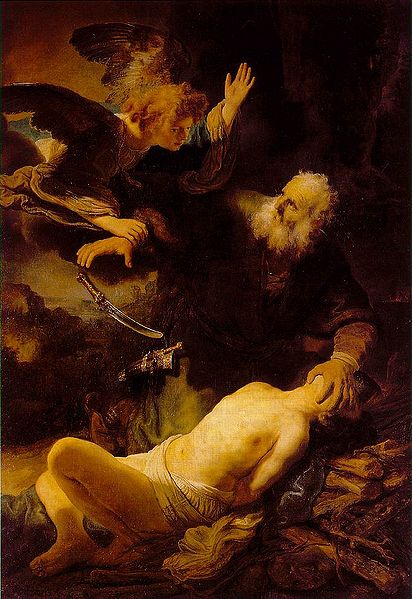
Rembrandt Harmenszoon van Rijn (15 July 1606 – 4 October 1669), See above
Giovanni Battista Piazzetta, (Giacomo Piazzetta) (1682 - 1754) Italian Artist. Giovanni Battista Piazzetta "did not care greatly for honors and neither for his own interest. He lived in love with his art," wrote his publisher. Piazzetta established himself by creating art utterly different from that of his Venetian contemporaries. Instead of spontaneous improvisation, intense color palettes, and decorative effects--often in the popular fresco medium--Piazzetta worked slowly in almost monochromatic oils, creating religious canvases and enigmatic genre pictures. "He is a snail," said a Swedish visitor.
His sculptor father probably introduced Piazzetta to art. Study with Giuseppe Maria Crespi in Bologna likely ignited his fascination with somber, dramatic effects and his interest in genre painting. Piazzetta emulated Crespi by portraying common people. By the 1740s he owned an active studio concentrating on church commissions and genre scenes.
Piazzetta's renowned drawings of half-length figures and heads documented the people of Venice. Traditionally, Venetian painters did not consider drawings as independent works of art, but Piazzetta created a new art form, giving drawing a status equal to painting in importance and quality. After being appointed director of the newly founded academy Scuola di Nudo (School of the Nude) in 1750, Piazzetta devoted himself to teaching. More on Giovanni Battista Piazzetta
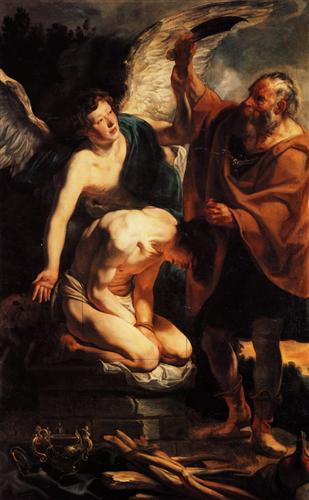
Jacob Jordaens (19 May 1593 – 18 October 1678) was a Flemish painter, draughtsman and tapestry designer known for his history paintings, genre scenes and portraits. After Peter Paul Rubens and Anthony van Dyck, he was the leading Flemish Baroque painter of his day. Unlike those contemporaries he never travelled abroad to study Italian painting, and his career is marked by an indifference to their intellectual and courtly aspirations. In fact, except for a few short trips to locations in the Low Countries, he remained in Antwerp his entire life. As well as being a successful painter, he was a prominent designer of tapestries. Like Rubens, Jordaens painted altarpieces, mythological, and allegorical scenes, and after 1640—the year Rubens died—he was the most important painter in Antwerp for large-scale commissions and the status of his patrons increased in general. However, he is best known today for his numerous large genre scenes based on proverbs in the manner of his contemporary Jan Brueghel the Elder, depicting The King Drinks and As the Old Sing, So Pipe the Young. Jordaens' main artistic influences, besides Rubens and the Brueghel family, were northern Italian painters such as Jacopo Bassano, Paolo Veronese, and Caravaggio. More on Jacob Jordaens

Just as Abraham was about to sacrifice his son, he was interrupted by "the angel of the LORD", and he saw behind him a "ram caught in a thicket by his horns", which he sacrificed instead of his son.
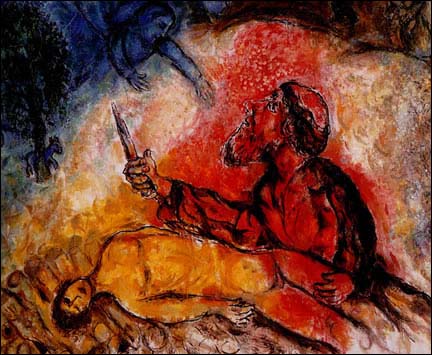

The Book of Genesis does not tell the age of Isaac at the time. The Talmudic sages teach that Isaac was thirty-seven, likely based on the next biblical story, which is of Sarah's death at 127, being 90 when Isaac was born.
The event occurred at "the mount of the LORD". (The hill on which Solomon was said to later build the Temple, now believed to be the Temple Mount in Jerusalem).
The majority of Jewish religious commentators argue that God was testing Abraham to see if he would actually kill his own son, as a test of his loyalty. However, a number of Jewish Biblical commentators from the medieval era, and many in the modern era, read the text in different ways. (Child sacrifice, at that time, was actually "rife among the Semitic peoples," "in that age, it was astounding that Abraham's God should have interposed to prevent the sacrifice, not that He should have asked for it.")
In some later Jewish writings, the theology of a "divine test" is rejected, and the sacrifice of Isaac is interpreted as a "punishment" for Abraham's earlier "mistreatment" of Ishmael, his elder son, whom he expelled from his household at the request of his wife, Sarah.
Adi Holzer (21st April 1936 in Stockerau in Vienna in Lower Austria) is an Austrian visual artist, illustrator, draftsman, painter, graphic artist, glass painter and sculptor of bronze sculptures and glass sculptures. He works alternately in his studios in Værløse in Denmark and Winklern in Austria. In Austria, he is a member of the Carinthian Art Association. More on Adi Holzer

The Quran states that when Abraham asked for a righteous son, God granted him a son possessing forbearance. The son is not however named directly in the Quran. When the son was able to walk and work with him, Abraham saw a vision about sacrificing his son. When he told his son about it, his son agreed to fulfill the command of God in the vision. When they both had submitted their will to God and were ready for the sacrifice, God told Abraham he had fulfilled the vision, and provided him with a ram to sacrifice instead. God promised to reward Abraham. The next two verses state God also granted Abraham the righteous son Isaac, and promised more rewards.
Muslim scholars have endorsed the belief that it was the first-born son Ismail, not Isaac, who was asked to be sacrificed in the vision, and that the second son Isaac was born later as one of the rewards for Abraham's fulfillment of his vision. More on this painting
Eid al-Adha, "Festival of the Sacrifice", is the second of two religious holidays celebrated by Muslims worldwide each year. It honors the willingness of Abraham (Ibrahim) to sacrifice his son, as an act of submission to God's command, before God then intervened, through his angel Jibra'il and informs him that his sacrifice has already been accepted. The meat from the sacrificed animal is preferred to be divided into three parts. The family retains one third of the share; another third is given to relatives, friends and neighbors; and the remaining third is given to the poor and needy. More on Eid al-Adha


For his obedience he received another promise of numerous descendants and abundant prosperity. After this event, Abraham went to Beersheba.
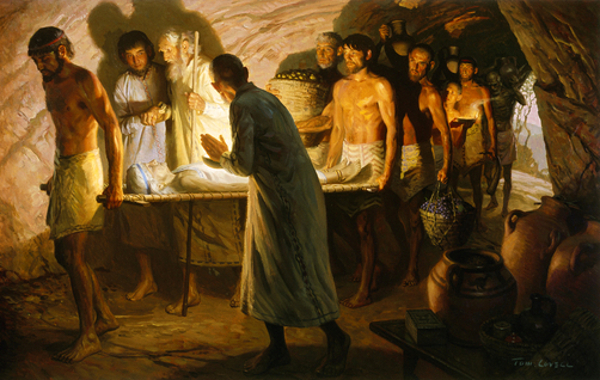
Later years Sarah died, and Abraham buried her in the Cave of the Patriarchs (the "cave of Machpelah"), near Hebron which he had purchased along with the adjoining field from Ephron the Hittite. After the death of Sarah, Abraham took another wife, a concubine named Keturah, by whom he had six sons: Zimran, Jokshan, Medan, Midian, Ishbak, and Shuah. Abraham lived 175 years, and was buried in the cave of Machpelah by his sons Isaac and Ishmael.
Please visit my other blogs: Art
Collector, Mythology, Marine
Art, Portrait of a Lady, The
Orientalist, Art of the Nude and The
Canals of Venice, Middle
East Artists, and 365 Saints, also visit my Boards on Pinterest
Images are copyright of their respective owners, assignees or others.
Some Images may be subject to copyright
I don't own any of these images - credit is always given when due unless
it is unknown to me. if I post your images without your permission, please tell
me.
I do not sell art, art prints, framed posters or reproductions. Ads are
shown only to compensate the hosting expenses.
If you enjoyed this post, please share with friends and family.
Thank you for visiting my blog and also for liking its posts and pages.
Please note that the content of this post primarily consists of articles
available from Wikipedia or other free sources online.

-xx-Abraham-journeying-to-the-land-of-Canaan.jpg)













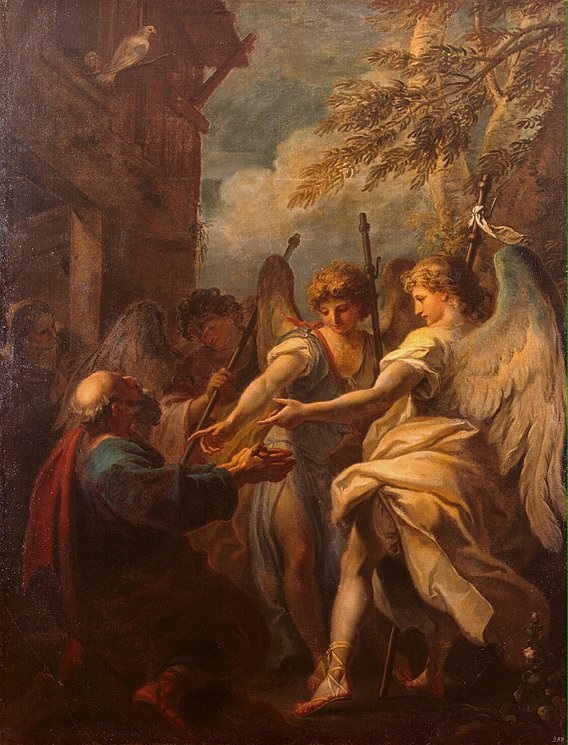



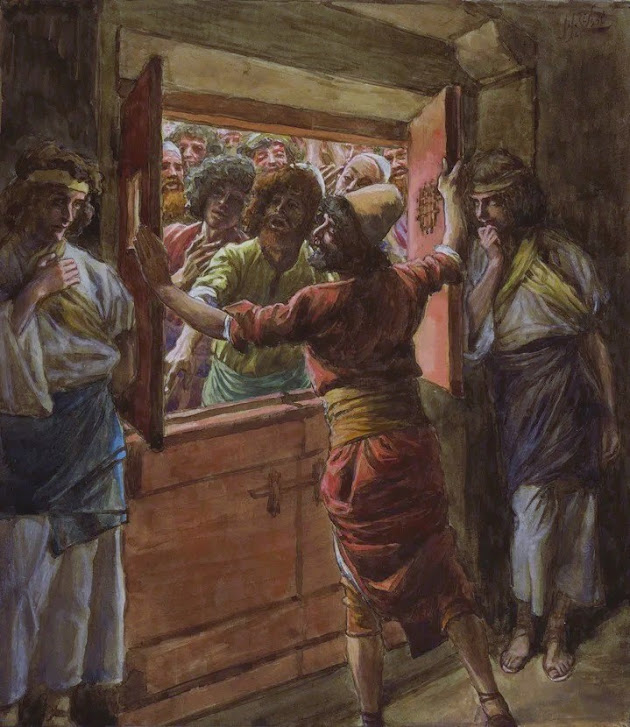










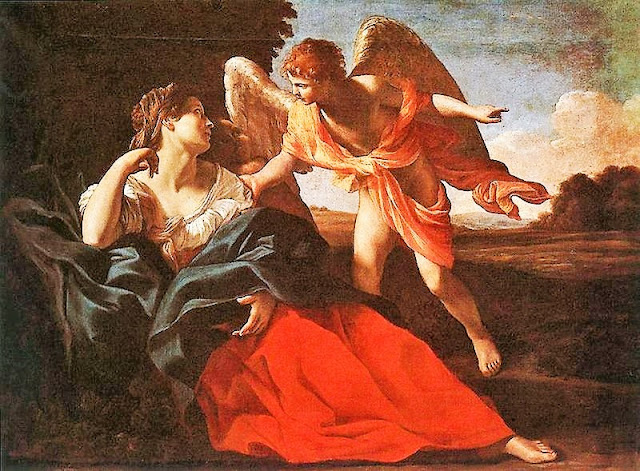








Thank you so much for sharing.
ReplyDeleteVery glad you enjoyed and that you for your nice comment
DeleteGreat collection of paintings! As the art teacher in a Christian school, I appreciate all your work.
ReplyDeleteThank you! I'm glad you enjoyed...
ReplyDelete